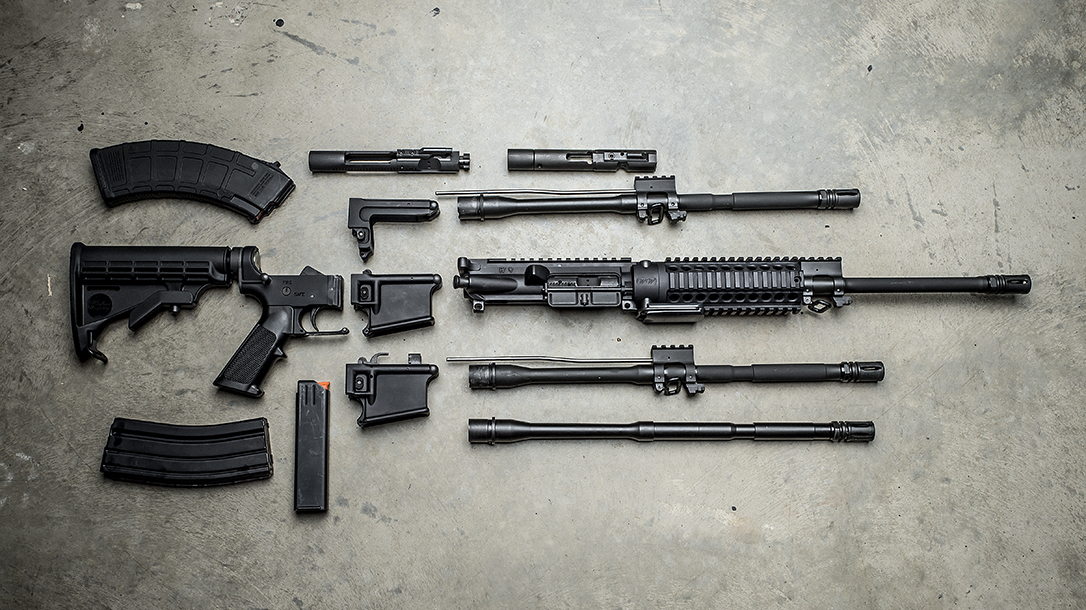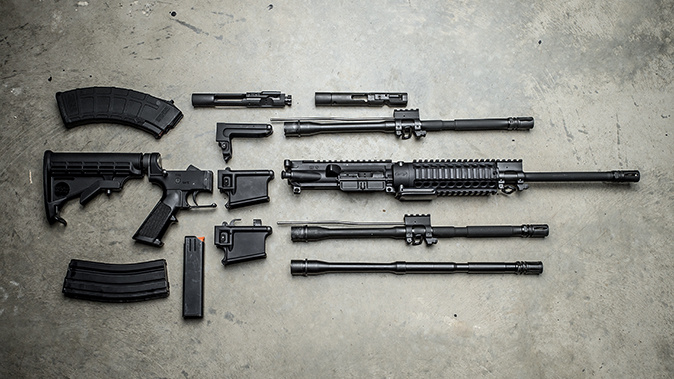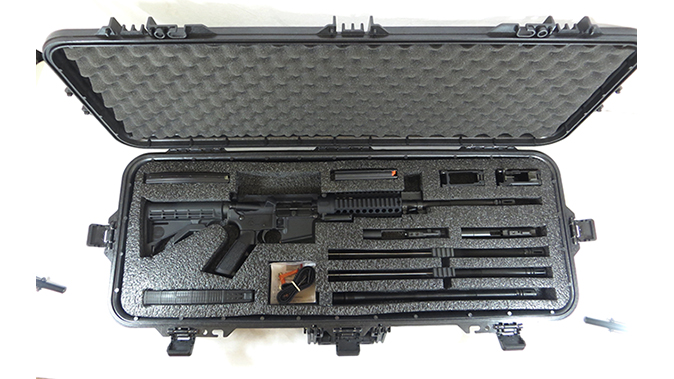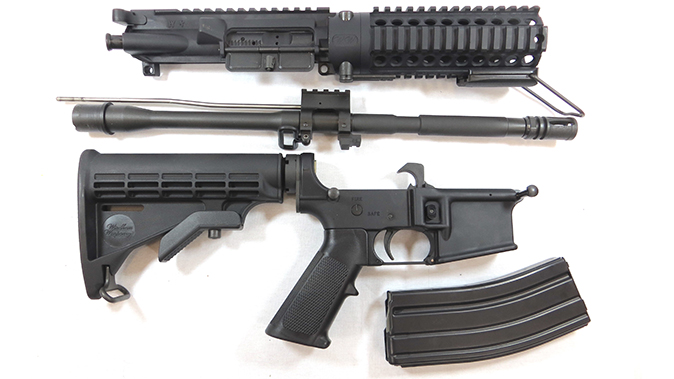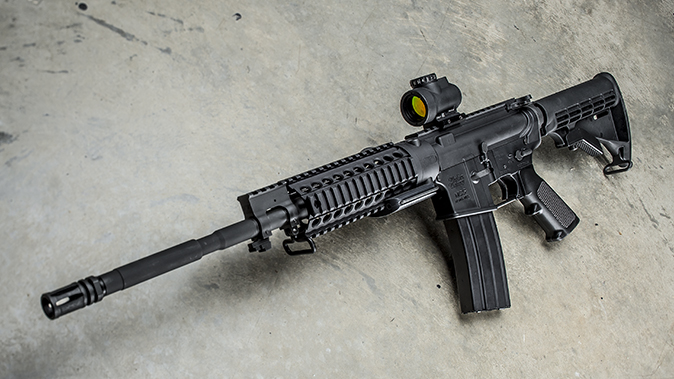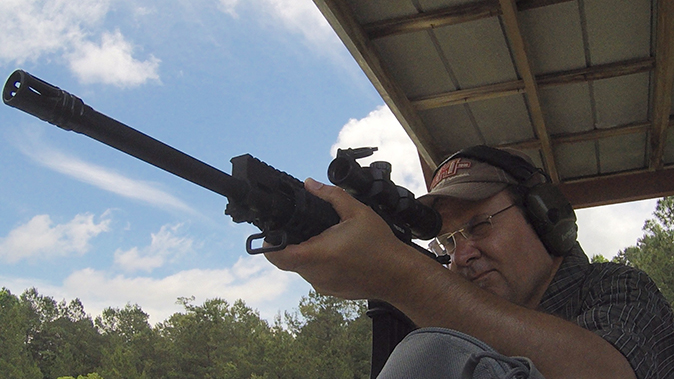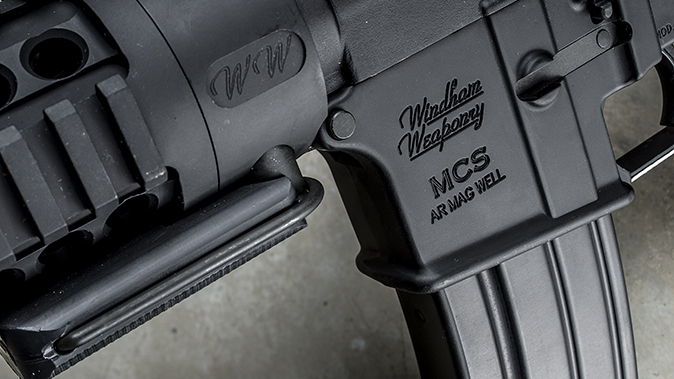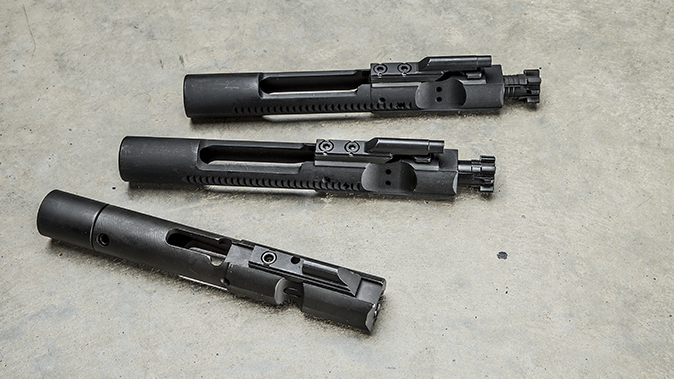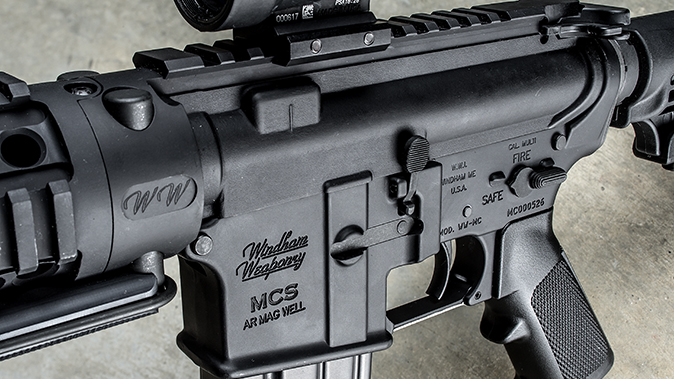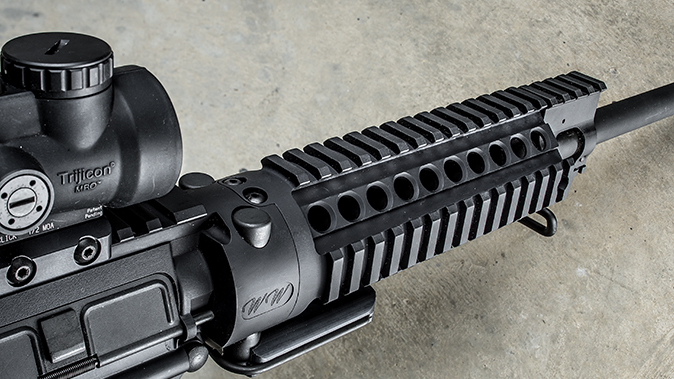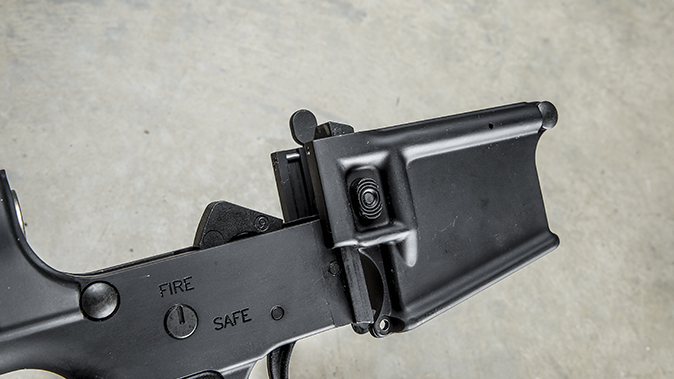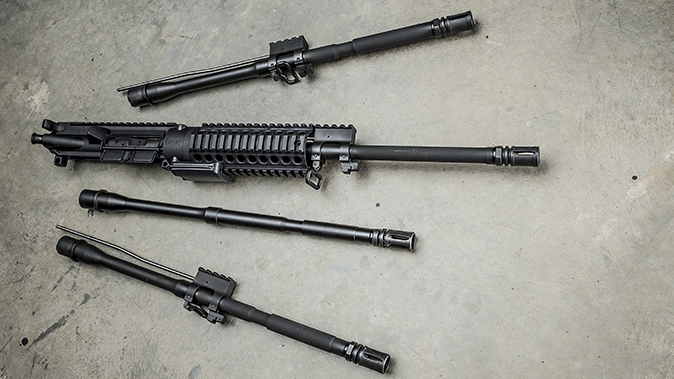Most shooters know that the AR platform is modular. What Windham Weaponry has done with its new RMCS-4 is offer an AR that not only kicks modularity up a few notches but also creates a highly versatile and flexible rifle that can easily switch between four different chamberings. The 5.56mm NATO, 300 Blackout, 7.62x39mm and 9mm are some of the most popular chamberings in use today, and the RMCS-4 feeds off all of them reliably.
In fact, the RMCS-4—part of Windham’s new Multi-Caliber System series—can swap calibers in about the time it takes to load one 30-round magazine by hand. This versatility means the same AR-platform rifle can be used to hunt, defend and train using whatever ammunition is available.
Advertisement — Continue Reading Below
Windham Weaponry was wise to offer the RMCS-4 as a cased set. Once you open the Plano hard case, you’ll find a foam insert holding an assembled rifle, three additional barrels, two additional bolt carrier groups, two additional magazine wells, three magazines, a sling and a conversion tool. If I had to pick centerfire chamberings to have on hand, I’d easily choose the 5.56mm, 7.62x39mm and 9mm. The 300 Blackout is more specialized, meaning it’s less common. But with a sound suppressor, the 300 BLK allows you to hunt in relative silence. You won’t alert neighbors or nearby predators. If there is anything missing from the RMCS-4 case, it’s an optic and ammo. You’re on your own for those.
Windham’s Multi-Caliber System is well thought out, practical and reliable. My biggest concern was whether or not the rifle would hold its zero between caliber swaps, but I found that removing/replacing the barrel assemblies barely affected the point of impact. Whatever small changes occurred were negligible. A competitive shooter might argue that point, but the RMCS-4 was not designed for shooting small groups at distance. It was designed to feed on all sorts of ammo to defend your homestead and pull double duty as a hunting rifle.
The caliber-change design is smart because, as you switch barrel assemblies, you can also swap out magazine wells to use standard AR, AK and Colt-style magazines as needed. So not only can you scrounge ammo, but you can also utilize scrounged magazines.
Advertisement — Continue Reading Below
How It Works
Make certain you’ve fully cleared the weapon. The barrel assemblies are removed and attached to the upper receiver via a bail clasp on the underside of the handguard that, when flipped outward, allows a retaining block to slide toward the muzzle, exposing two barrel-retaining arms. The barrel-retaining arms are rotated 90 degrees outward, allowing the barrel/gas tube assembly to be pulled out from the handguard. When you switch between 5.56mm and 300 BLK barrel assemblies, you can look through the well-ventilated handguard to see that the gas tube is properly aligned. The handguard also has a notch inside to aid in alignment. Of course, switching from 5.56mm to 300 BLK and vice versa is the easiest caliber swap, since these chamberings share the same magazines and bolt carrier group. Switching to the 7.62x39mm and 9mm requires a few more parts and steps.
To switch to the 7.62x39mm, you need to separate the upper receiver from the lower receiver. You then need to compress a small retaining pin at the front of the triggerguard—Windham supplies an orange-colored tool for this purpose that also acts as a chamber flag—and pivot the triggerguard away from the magazine well. Press the magazine release button and the magazine well slides up and off of the lower. You then attach the magazine well that is compatible with AK-style magazines. AK magazines are inserted in the same roll- and-lock method used on an AK-platform rifle.
Next Steps
The next component to swap is the bolt carrier group. Windham makes it easy to identify the three bolt carrier groups in the system. The 7.62x39mm version is marked “AK” on the side. The bolt head also has three rings milled into it to separate it from the other two bolt carrier groups. Like an AK rifle, the bolt does not lock back after the last round is fired.
Advertisement — Continue Reading Below
Switching to 9mm follows a similar process of changing out the barrel, magazine well and bolt carrier group. The dedicated 9mm magazine well is flared so inserting the skinny Colt-style magazines was fast and sure during testing. The 9mm conversion uses a blowback operating system, so there is no gas tube and its bolt carrier group is noticeably heavier.
Other than the caliber-conversion aspect of the rifle, the RMCS-4 is similar to Windham’s other AR carbines and uses forged 7075-T6 aircraft-grade aluminum upper and lower receivers. The lower features standard AR furniture, including a collapsible M4-style stock and an A2-style pistol grip. The safety, magazine release, bolt release and trigger are all mil-spec. The handguard is proprietary due to the bale clasp and retaining arms, but it offers four Picatinny rails for mounting accessories. And while the handguard and other Multi-Caliber System-specific parts are not compatible with aftermarket models, almost every other component is.
Four-Gun Testing
To test the RMCS-4, I mounted a TruGlo 1-4x24mm Tru-Brite 30 Hunter scope with a mil-dot reticle since I thought this optic would work well with the range of calibers. The scope is equipped with a capped windage turret while the elevation turret is left un-capped so you can quickly dial in elevation changes—something you’ll need when firing a rifle that shoots a variety of bullet types and weights at different velocities. A cheat sheet taped to the scope or stock would help you save some time and ammunition.
Advertisement — Continue Reading Below
I experienced no issues swapping calibers. The process is simple and straightforward. As mentioned, the small point-of-impact shifts were negligible and totally expected of such a multi-caliber rifle. During the range test I’d shoot, swap barrels, shoot and swap barrels again, and I found that the rifle was able to keep its zero with each barrel. At 100 yards, all of the rifle calibers—5.56mm, 300 Blackout and 7.62x39mm—exhibited about 1-MOA accuracy on average with three-shot groups, with many “best” groups under an inch wide.
I was surprised by this level of accuracy since I was constantly swapping barrels. Plus, the RMCS-4’s mil-spec-style trigger had a 7.6-pound pull weight, which doesn’t exactly endear it to accurate shooting at distance. Also, it’s important to note that you should use gloves when it comes to changing out hot barrel assemblies.
Advertisement — Continue Reading Below
5.56mm & 9mm
In 5.56mm NATO, the best groups came with Aguila and HPR ammo—both measuring just 0.24 inches. In 300 Blackout, I was able to get a 0.28-inch three-shot group at 100 yards using Sig Sauer’s supersonic 125-grain SMK ammo. The smallest group with the 7.62x39mm ammo at 100 yards was 0.51 inches—which is pretty damn good for economy ammo. In 9mm, the rifle operated differently since it uses the blowback system rather than direct-impingement system. At 25 yards, I had no problems shooting tight groups, and the recoil was negligible. The Colt-style 9mm magazine included with the RMCS-4 worked fine. I had no issues with any of the caliber conversions, and the accuracy was quite exceptional for a rifle you can break down into pieces in a matter of seconds. The rifle also ran flawlessly with all of the test ammo.
I like the versatility and portability of the Windham Weaponry RMCS-4. It proved it can feed off a variety of ammo with no perceptible point-of-impact shifts. I also found that cleaning the rifle was a lot simpler and faster because of its unique design.
This might be the ultimate go-to AR, especially if you need to switch chamberings in the field. It’ll work well for self-defense, hunting and training. And if you’re a frugal buyer, think about all you’re getting for under $3,000. The math works out to less than $750 per gun. That’s a lot of practicality and versatility wrapped into one slick package.
Advertisement — Continue Reading Below
Windham Weaponry RMCS-4 Specs
- Caliber: 5.56mm, 300 BLK, 7.62x39mm, 9mm
- Barrel: 16 inches
- OA Length: 32-36 inches
- Weight: 6.4 pounds (empty)
- Stock: Collapsible
- Sights: None
- Action: Direct impingement semi-auto (blowback for 9mm)
- Finish: Matte black
- Capacity: 30+1 (20+1 for 9mm)
- MSRP: $2,971
Windham Weaponry RMCS-4 Performance
| Load | Velocity | Accuracy |
|---|---|---|
| Aguila 62 FMJ (5.56mm) | 2,979 | 0.24 |
| Federal American Eagle 55 FMJ (5.56mm) | 2,907 | 0.52 |
| HPR Black Ops 62 OTF (5.56mm) | 2,727 | 0.24 |
| Hornady 110 V-MAX (.300 BLK) | 2,318 | 0.96 |
| Sig Sauer 125 SMK (.300 BLK) | 2,134 | 0.28 |
| Sig Sauer 200 SMK (.300 BLK) | 958 | 0.88 |
| Hornady 123 SP (7.62x39mm) | 2,091 | 0.47 |
| TulAmmo 122 FMJ (7.62x39mm) | 2,320 | 0.70 |
| Winchester 123 SP (7.62x39mm) | 2,208 | 0.40 |
| Aguila 124 FMJ (9mm) | 1,337 | 1.00 |
| Atlanta Arms 147 FMJ (9mm) | 1,014 | 0.80 |
| Sig Sauer 115 V-Crown JHP (9mm) | 1,146 | 0.42 |
*Bullet weight measured in grains, velocity in fps by chronograph and accuracy in inches for best three-shot groups at 100 yards (25 yards for 9mm).
